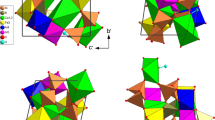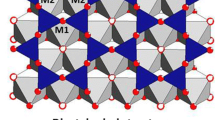Abstract
An inverse Monte Carlo (MC) method was developed to determine the distribution of octahedral cations (Al3+, Fe3+, and Mg2+) in bentonite illite–smectite (I–S) samples (dioctahedral 2:1 phyllosilicates) using FT–IR and 27Al MAS NMR spectroscopies. FT–IR allows determination of the nature and proportion of different cation pairs bound to OH groups measuring the intensities of OH-bending bands. 27Al MAS NMR data provide information about cation configuration because 27Al MAS NMR intensity depends on Fe distribution. MC calculations based on FT–IR data alone show Fe segregation by short-range ordering (Fe clusters within 9 to 15 Å from a given Fe atom). Fe segregation increases with illite proportion. MC calculations based on IR and 27Al NMR simultaneously yield similar configurations in which Fe clusters are smaller. The latter calculations fail to build appropriate cation distributions for those samples with higher number of illite layers and significant Fe content, which is indicative of long-range Fe ordering that cannot be detected by FT–IR and 27Al MAS NMR. The proportion of Mg–Mg pairs is negligible in all samples, and calculations, in which the number of Mg atoms, as second neighbours, is minimised, create appropriate configurations.
Similar content being viewed by others
Author information
Authors and Affiliations
Additional information
Received 13 July 2000 / Accepted 2 February 2001
Rights and permissions
About this article
Cite this article
Sainz-Díaz, C., Cuadros, J. & Hernández-Laguna, A. Analysis of cation distribution in the octahedral sheet of dioctahedral 2:1 phyllosilicates by using inverse Monte Carlo methods. Phys Chem Min 28, 445–454 (2001). https://doi.org/10.1007/s002690100171
Issue Date:
DOI: https://doi.org/10.1007/s002690100171




